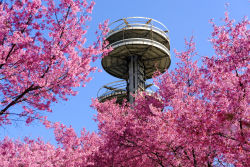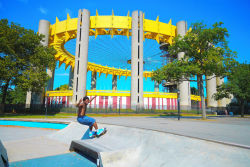Flushing Meadows Corona Park
New York State Pavilion
While not much is left of the original 1964-65 world’s fair, the site’s sparcity belies the intense social significance that the Peace Through Understanding exhibition had. The 1960s were years of upheaval and change in the United States, and the Fair attempted to encapsulate those feelings within its boundaries. The civil rights movement was in full swing, as was the Vietnam War, and President John F. Kennedy had been assassinated a year earlier. New York City was coming out from under the yoke of Parks Commissioner Robert Moses, a man who had single handedly changed the physical, and by default social, structure of the city. Technologies never before seen, like the computer, were unveiled and the artworks of a new generation were being shown alongside those of the old masters, like Michaelangelo’s Pieta.
The New York State Pavilion was constructed for the World’s Fair in Flushing Meadows-Corona Park. Designed by architect Philip Johnson (born 1906), the “Tent of Tomorrow” measures 350 feet by 250 feet, with sixteen 100-foot columns suspending a 50,000 square-foot roof of multi-colored panels. The popular exhibit for the state of New York also held three towers, measuring 60 feet, 150 feet, and 226 feet. The two shorter towers held cafeterias for the fair, and the tallest tower, as the highest point of the fair, held an observation deck. Fair visitors ascended the towers in the “Sky Streak” capsule elevators.
The pavilion included a display from the New York State Power Authority with a 26-foot scale replica of the St. Lawrence hydroelectric plant. The pavilion’s mezzanine featured art from local museums and information about the state’s industries along a path called “Highways through New York.” The Fine Arts Gallery showed pieces from the Hudson River School and portraits of New York State colonists. Approximately six million people visited the New York State Pavilion.
Perhaps the most spectacular feature of the exhibit was the Texaco Company’s map of New York State. The map was designed with 567 terrazzo mosaic panels, each weighing 400 pounds. Rand McNally & Company assisted in constructing the $1,000,000 map, which featured the 50,000 square miles of New York State in meticulous detail. The cities, towns, highways, roads, and Texaco stations were accurately mapped in the 9,000 square-foot design. After the fair, the space under the tent was used as a roller skating rink and as a performance space by the Council for International Recreation, Culture, and Lifelong Education. By 1976, the roof above the map became unstable and the tent was removed, exposing the map of New York State to the ravages of weather.
The New York State Pavilion also included the adjacent “Theaterama,” which exhibited pop art works by Andy Warhol (1928-1987) and Roy Lichtenstein (1923-1997) among others. The “Theaterama” also screened a 360-degree film about the wonders of New York State, from Jones Beach to Niagara Falls. The space was converted to the Queens Playhouse in 1972 with its first production, George Bernard Shaw’s “Pygmalion,” opening in October of the same year. The theater continued to operate until 1985 and was renovated and reopened in 1994. Borough President Claire Shulman, the Department of Cultural Affairs, the City Council, and private donors funded the $4 million renovation.
Other improvements of the fairgrounds include a $24,000 partial reconstruction of the lower tower of the New York State Pavilion funded by Mayor Rudolph W. Giuliani in 1998, and a $165,000 lighting installation for the Queens Theatre-In-The-Park funded by Borough President Claire Shulman in 1999. Visible from the Grand Central Parkway, the Van Wyck Expressway, and the Long Island Expressway, and located near the Unisphere and the New York City Building, the New York State Pavilion remains an important, historical landmark of Flushing Meadows-Corona Park.
Check out your park's Vital Signs
Clean & Safe
Green & Resilient
Empowered & Engaged Users
Share your feedback or learn more about how this park is part of a
Vital Park System

Know Before You Go

Downloads
- New York State Pavilion Listening Session
- Strategic Framework Plan: Introduction
- Strategic Framework Plan: Site Analysis
- Strategic Framework Plan: Conceptual Framework, Part I
- Strategic Framework Plan: Conceptual Framework, Part II
- Strategic Framework Plan: Vision and Goals, Part I
- Strategic Framework Plan: Vision and Goals, Part II
- Strategic Framework Plan: Appendix, Part I
- Strategic Framework Plan: Appendix, Part II
Links
- National Tennis Center Strategic Vision Project
- World Ice Arena
- Citi Field
- Mets Ticketing
- USTA National Tennis Center
- US Open
- Terrace on the Park Catering Hall
- New York Hall of Science
- Queens Museum
- Queens Botanical Garden
- Queens Theatre
- Queens Wildlife Conservation Center
- Fantasy Forest at the Flushing Meadows Carousel
- Wheel Fun Rentals
- Alliance for Flushing Meadows Corona Park
Contacts
General Park Info: (718) 760-6565
Pitch N Putt Golf and Miniature Golf : (718) 271-8182
World's Fair Marina on Flushing Bay : (718) 478-0480
World's Fair Marina Restaurant: (718) 898-1200
Terrace on the Park: (718) 592-5000
Citi Field: (718) 699-4220
Mets Ticketing: (718) 507-TIXX
USTA National Tennis Center: (718) 760-6200
US Open/USTA: (914) 696-7000
New York Hall of Science: (718) 699-0005
Queens Museum: (718) 592-9700
Queens Botanical Garden: (718) 886-3800
Queens Theatre: (718) 760-0064
Queens Wildlife Conservation Center: (718) 271-1500
Sports Permits: (718) 393-7272
Picnic/Barbeque Permit for Large Groups: (718) 393-7272
Wheel Fun Rentals: (917) 231-5519
World Ice Arena: (718) 760-9001
Al Oerter Recreation Center: (718) 353-7853
Flushing Meadows Corona Park Pool & Rink: (718) 271-7572
Special Events Permits: (718) 760-6560
Tennis Permits: (718) 393-7276
Volunteer Coordinator: (718) 760-6561










